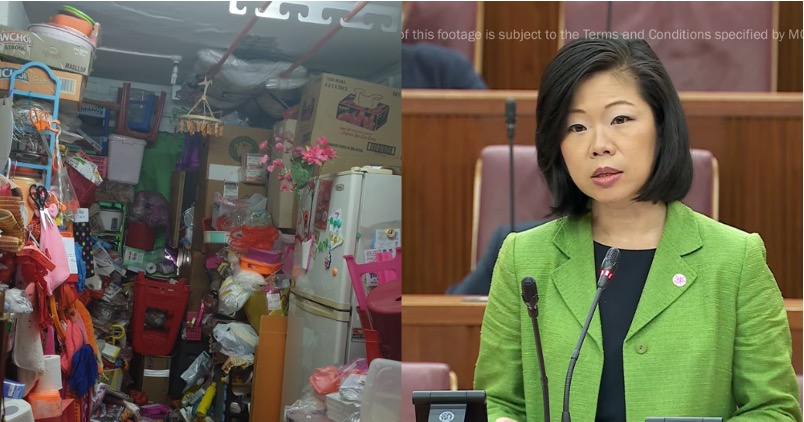Follow us on Telegram for the latest updates: https://t.me/mothershipsg
In the first half of this year, the Hoarding Management Core Group (HMCG) managed to “reduce the severity” of 210 cases of hoarding, and are actively monitoring these cases to prevent recurrence, Senior Minister of State for National Development, Sim Ann, said in Parliament on Sep. 12.
She was responding to several Parliamentary Questions (PQs) filed by Members of Parliament (MPs) on the Hoarding Management Framework and reducing fire hazards in Housing Development Board (HDB) flats.
There were several fire cases in HDB flats across Singapore in August.
Sim added that the HMCG is working on another 260 active hoarding cases, as it is difficult to gain the cooperation to declutter.
The Hoarding Management Core Group was set up in 2014 and is led by the Municipal Services Office (MSO) to coordinate efforts across agencies and resolve protracted and severe hoarding cases.
The interagency group comprises a whole alphabet soup of agencies, statutory boards and other bodies like HDB, the National Environment Agency (NEA), the Animal and Veterinary Service (AVS) of NParks, the Singapore Civil Defence Force (SCDF), Ministry for Social and Family Affairs (MSF), the People’s Association (PA) and the Agency for Integrated Care (AIC).
How are hoarding cases managed?
According to Sim, hoarding cases are assessed and prioritised based on whether there is a threat to public health and safety.
Where risks are identified to the extent that established rules and laws are violated, regulatory agencies will issue orders or take enforcement action on the hoarder or the homeowner.
For example, according to Sim, NEA may order the homeowner to remove items contributing to pest infestations in their home. SCDF may also order the owner to cease hoarding flammable items.
If the hoarder is suspected to have mental health issues, they will be referred to AIC and the Institute for Mental Health (IMH) for professional assessment and treatment.
Difficult to change deep-seated behaviour
Apart from enforcement, she added that the agencies work closely with healthcare workers and community partners, such as social workers from the Family Service Centres, grassroots leaders, volunteers and the hoarder’s family members.
“If your family member is a hoarder, we seek your strong support on agency's efforts to declutter as family intervention has proven to be a major success factor in hoarding intervention,” Sim said.
She added that even with the involvement of mental health agencies and professionals, “deep-seated issues may still result in recurrence as behavioural change is unlikely to happen overnight”.
Sim shared the difficulties faced by government personnel and social workers, who have encountered cases such as hoarders refusing to open their doors or threatening self-harm rather than to lose their belongings.
Plans to “intensify actions” to keep corridors clear
Moving forward, she said that there are plans to “intensify actions” to keep corridors clear for passage.
“In the coming months, agencies intend to work with Town Councils to step up enforcement on cluttered corridors,” she said.
The MSO will also work with the media as well as social and grassroots workers to further spread and reinforce key messages through more public education on the dangers of hoarding and project corridors.
The agency will also continue to tackle known cases of egregious hoarding within flats.
According to Sim, if there were order issues for public health and safety reasons, and the hoarders are cooperative, the agencies will then proceed to declutter through the community-based approach with the assistance of volunteer groups.
“However, even in cases where hoarders are unwilling to part with their items, we will act firmly in the interest of public health and safety to intervene,” she added.
“We seek the understanding of the public that we cannot allow decluttering efforts to be blocked by the remonstrations of individuals who may be endangering public health and safety with their actions,” she added.
One fire extinguisher at the lift lobby for every two HDB flats
In response to PQs filed about fire hazards in HDB flats, Minister of State for Home Affairs and National Development Faishal Ibrahi, shared that SCDF is embarking on a trial with HDB, Town Councils and Temasek Foundation to place and maintain one fire extinguisher at a lift of every two blocks.
The fire extinguishers placed at the lift lobbies are for use by residents during fire emergencies.
He also gave an update on the Home Fire Alarm Device (HFAD) Assistance Scheme, which was completed in June 2021. The scheme was to provide free installation of HFADs for all HDB public rental flats on a non-mandatory basis.
Faishal shared that the take-up rate as of the completion of the initiative was 75 per cent.
“HDB will progressively install HFADs in the remaining 25 per cent of public rental flats when their tenants’ leases end,” he added.
As the number of fires in HDB estates continues to decrease annually, and the fire fatality rate remains low, Faishal said that the Ministry of Home Affairs does not currently intend to expand the HFAD Assistance Scheme.
Top images via Fahmi Aliman/Facebook and Sim Ann/Facebook
If you like what you read, follow us on Facebook, Instagram, Twitter and Telegram to get the latest updates.
